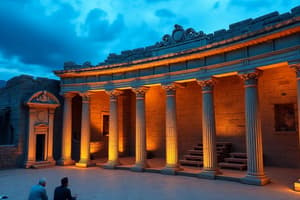Podcast
Questions and Answers
What event was depicted in the Abydos Passion play?
What event was depicted in the Abydos Passion play?
- The last supper
- The crucifixion of Christ (correct)
- The birth of Christ
- The resurrection of Christ
The tradition of theatre originated from primitive rituals according to the Cambridge Anthropologists.
The tradition of theatre originated from primitive rituals according to the Cambridge Anthropologists.
True (A)
What is a stele and provide an example?
What is a stele and provide an example?
A stele is a carved stone that tells a story; an example is the 10 commandments.
In Ancient Athens, the first tragic playwright to win a competition at the City Dionysia was ______.
In Ancient Athens, the first tragic playwright to win a competition at the City Dionysia was ______.
Match the following theatre elements with their descriptions:
Match the following theatre elements with their descriptions:
What is a Dithyramb?
What is a Dithyramb?
All Greek actors did not wear masks during performances.
All Greek actors did not wear masks during performances.
Name the two kinds of characters in Noh theatre.
Name the two kinds of characters in Noh theatre.
Flashcards
What is a 'stele'?
What is a 'stele'?
A carved stone monument that tells a story. Think of it as a 'stone storybook.'
Tragedy
Tragedy
A type of ancient Greek theatre performance that focused on the suffering and downfall of a tragic hero.
What is the 'orchestra' in a Greek theatre?
What is the 'orchestra' in a Greek theatre?
A circular, semi-circular area in an Ancient Greek theatre where the chorus performed and the audience sat. Think of it as the 'stage' for the chorus.
What is the 'skene' in a Greek theatre?
What is the 'skene' in a Greek theatre?
Signup and view all the flashcards
What is the 'ekkyklema'?
What is the 'ekkyklema'?
Signup and view all the flashcards
What is 'Noh' theatre?
What is 'Noh' theatre?
Signup and view all the flashcards
What is the 'Shite' in a Noh play ?
What is the 'Shite' in a Noh play ?
Signup and view all the flashcards
What is the 'Waki' in a Noh play?
What is the 'Waki' in a Noh play?
Signup and view all the flashcards
Study Notes
Theatre Introduction
- Preliterate human history: 99.9% of human history
- Abydos Passion play: depicted the crucifixion of Christ, a European form of theatre used to apply European perspectives in non-European content
- Stele: a carved stone monument, often telling a story (e.g., the Ten Commandments)
- Ritual vs Theatre: ritual is considered more "efficacious," theatre more "entertainment"
- Cambridge Anthropologists/Ritualists: theorized theatre developed from ritual practices (a theory not widely accepted). Religious rituals were believed to have evolved into a more aesthetic art form of theatre.
Theatre in Ancient Athens
- Thespis: first tragic playwright to win a competition at the City Dionysia
- Thespian: a term still used for actors today
- Dithyramb: poems chanted and sung by men's choruses.
- Lenaia Festival: held in winter, mainly for Athenians, used to make fun of the government
- City Dionysia: held in spring, for everyone in the surrounding area of Athens. Held at the base of the Akropolis.
- Chorus: a group of 12-15 men, representing a collective character, sang dialogue, and danced
- Masks: All Greek actors wore masks, as did the chorus.
Japanese Traditional Theatre: Noh
- Noh: stands for talent and ability, comes from the word Nohgaku
- Masks: represent actors re-incarnating past persons/spirits; allowing audiences to use their imagination to feel emotion
- Purpose of Noh masks: very stylized and ritualistic; highly symbolic; takes a long time to perform
- Characteristics of Noh:
- Minimalistic sets
- Dream-like actions
- Performed only by men
- Roles: the Shite (main protagonist) and the Waki (secondary character)
- Accompanied by a chorus (6-10 men and musicians).
- Performed on a small raised stage
Japanese Theatre: Kabuki
- Kabuki: comes from the word Kabuku, meaning bizarre or out of the ordinary
- Kabuki was aimed at common folk
- Onna-Kabuki (women's Kabuki): Originally performed by women, later banned because shoguns disliked women advertising their bodies on stage
- Wakashu-Kabuki: Young boys played roles, later banned
- Yaro-Kabuki: the form that is still performed today, using grown men performers
- Kabuki is a 5-act performance
Parts of the Theatre
- Skene: a low, house-like structure added to some ancient theatres, allowing action to take place on the roof
- Ekkyklema: used to expose interior scenes through a wheeled mechanism
- Orchestra: a circular semi-circle area in ancient Greek theatres
- Paradoi: passages into the orchestra, located between the theatron (audience seating) and the skene
- Thymele: a flat stone in the center of the orchestra
Studying That Suits You
Use AI to generate personalized quizzes and flashcards to suit your learning preferences.



